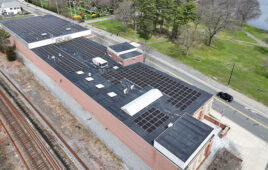 The landscape is dotted with the remains of bygone developments—places where factories churned out products and ships docked to receive them, for instance—which today are often considered brownfields. Brownfields are sites that may require environmental clean-up prior to redevelopment.
The landscape is dotted with the remains of bygone developments—places where factories churned out products and ships docked to receive them, for instance—which today are often considered brownfields. Brownfields are sites that may require environmental clean-up prior to redevelopment.
Still, because brownfields are often vacant or merely strewn with rubbish, they appear to solar advocates as land ripe for development. Another type of brownfield, the capped landfill, is frequently seeing new life as home to solar installations. But turning these sites into solar arrays can be challenging.
Brownfield Listings CEO Dan French knows dealing in previously used and sometimes contaminated land and real estate can be a complicated process. He worked for years for powerhouse Dow 30 industrial companies, divesting real estate with legacy issues leftover from prior use.
Sure, potential developers have to worry about the EPA and site cleanup, which can include soil, surface water or ground water remediation. But there’s a more fundamental problem when it comes to brownfield redevelopment: connecting seller and buyer.
“At BP, we had a large due diligence team and were spending a lot of money to move these sites, and it was still really difficult at times,” French said. “If you’re in a small town, for instance, with a small budget and you have an old factory, you have to wonder, ‘How do they access markets?’”
It was this question—combined with a particularly frustrating day at the office—that led French to start Brownfield Listings, a real-estate marketplace focused on the re-development of previously used land, including brownfields and contaminated real estate.
At Brownfield Listings real estate goes by a taxonomy of terms, including bluefields for sites with water resources or near waterways, greyfields for economically obsolete areas with structures and brightfields for land that is ripe for solar development.
As the solar industry matures, brightfields are expected to become key in brownfield redevelopment. Not only is this exemplified by the numerous solar arrays on capped landfills from New York to Los Angeles, but the various solar product lines developed specifically for them, such as ballasted ground-mounts that require no piling.
Sensing a trend, French last week launched a real estate portfolio feature on Brownfield Listings for solar energy development opportunities. Any parcel of land anywhere in the U.S. may list for free in the Brightfield Portfolio using the brightfield tag.
“You just go to Brightfield Portfolio, and you can cruise all the sites that have been published on an interactive map,” French said. “You can also create a profile so you can list your company.
“It’s a nice way to find people, similar to other networks like LinkedIn. We’re as much an ecosystem as a marketplace because we have all the players on one platform.”
Solar developers may be keen to develop brownfield sites because they can be cheaper and are available in many markets, even urban areas close to interconnection points.
In addition, French said, there are very motivated property owners and stakeholders, including public officials, that want to see these sites reused.
“They’re looking for an end use,” French said. “Solar fits that gap.”
Plus, he said, the EPA is often supportive of brightfields, especially since its launch of the Re-Powering America’s Land Initiative.
According to the EPA, brownfield sites have unique attributes that can lower development costs and shorten development timeframes (see graphic at the bottom of this article). Many properties offer developers a unique value proposition for renewable energy deployment, such as the ability to:
- Leverage existing infrastructure
- Reduce project cycle times through streamlined permitting and zoning
- Improve project economics with reduced land costs and tax incentives
- Gain community support through land revitalization efforts
- Protect open space
French said he only expects the market for brightfields to grow.
“The economics have changed, in both the solar and real estate space, and we’re very positive on the way those things come together, especially for the future,” he said. “Now there’s a place to list any landfill for lease to solar developers. Honestly, why wouldn’t we put panels on every landfill in the country?”
To see the Brownfield Listings’ Brightfield Portfolio, click here.




Tell Us What You Think!